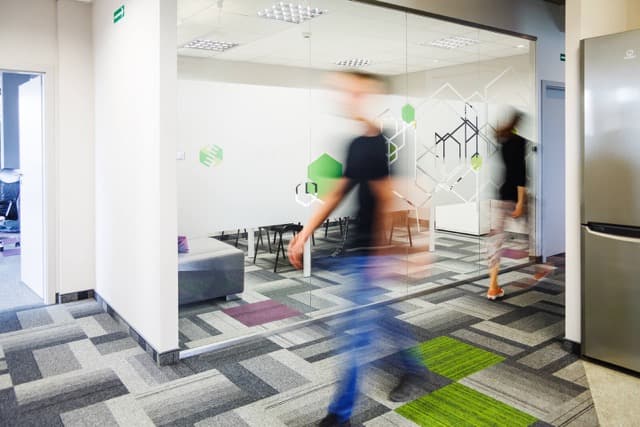
By Łucja , February 10, 2025 · 7 min read
How Core Web Vitals Impact e-Commerce: Maximizing Performance for Higher Sales
Did you know... 53% of mobile users won't wait longer than 3 seconds! We don't have enough time, they leave and don't come back. Every second matters.
Imagine this: You need to buy a last-minute gift online. You find the perfect item, click on the website, and... nothing happens. The page is still loading. Annoyed, you go back and choose a competitor's site instead. This happens all the time in online shopping, where speed is key. If a store's website is too slow, customers leave before even seeing its products.
Shoppers expect lightning-fast load times, seamless interactions, and visually stable pages. Even a slight delay in page speed can result in lost revenue and decreased customer satisfaction. This article explores the importance of Core Web Vitals (CWV), their impact on e-commerce revenue, and practical ways to optimize them for maximum business growth.
1. Why Speed Matters in e-Commerce
Website speed is a crucial factor in e-commerce success. Customers expect a seamless and fast browsing experience, and even minor delays can lead to frustration and lost sales. According to a study by WP Rocket, 47% of users expect a website to load in under 2 seconds. If a site takes longer, visitors tend to abandon their journey, leading to a drop in conversions.
Furthermore, Amazon and Walmart's internal data show that a 1-second delay in page load time can lead to a 7% drop in conversions, while just 100ms delay can reduce sales by 1%. These statistics highlight the direct link between speed and revenue in online stores.
Real-world examples demonstrate the impact of performance improvements:
✅ Vodafone improved their Largest Contentful Paint (LCP) by 31%, which resulted in an 8% increase in sales

source: web.dev
✅ redBus optimized their Interaction to Next Paint (INP), leading to a 7% boost in sales

source: web.dev
✅ AliExpress reduced their page load time by 36%, leading to a 10.5% increase in orders.
✅ Pinterest saw a 15% increase in organic traffic after improving page performance.
2. What Are Core Web Vitals?
Core Web Vitals are a set of performance metrics defined by Google to measure a site's user experience. These metrics impact SEO rankings and overall engagement. The three primary Core Web Vitals are:
- Largest Contentful Paint (LCP): Measures loading performance. To provide a good user experience, LCP should occur within 2.5 seconds
- Interaction to Next Paint (INP): Reflects interactivity. An optimal INP score should be below 200ms, ensuring that users experience minimal delays when interacting with a website.
- Cumulative Layout Shift (CLS): Evaluates visual stability. A CLS score below 0.1 prevents unexpected shifts that can disrupt the shopping experience.
A fast-loading site not only enhances the user experience but also ranks higher in Google search results, increasing organic traffic without additional marketing costs.
3. Business Impact: Why Performance = More Revenue
Optimizing Core Web Vitals is not just about meeting Google's guidelines - it has a direct impact on sales. Research from Major Digitalfound that:
- A 1 to 3-second delay in page load time increases bounce rates by 32%.
- 70% of online shoppers abandon their cart due to slow load times
- Google reported that 53% of mobile users abandon a site if it takes longer than 3 seconds to load.
- Mobile e-commerce sites that improve their speed by 1 second can see up to a 27% increase in conversions.
4. Hatimeria Revenue Calculator
Website performance is directly tied to business revenue, and understanding the financial impact of slow load times is crucial for making data-driven decisions. Hatimeria's Revenue Calculator is a powerful tool designed to estimate the potential revenue loss caused by suboptimal Core Web Vitals and help businesses take corrective actions.
Unlike generic performance calculators, Hatimeria’s tool is powered by a specially developed algorithm that accurately models the relationship between load times, conversion rates, and overall revenue impact. It helps businesses better understand the costs of poor performance and find the best ways to improve.
Hatimeria’s Revenue Calculator helps by:
1️⃣ Checking your website speed.
2️⃣ Estimating revenue loss.
3️⃣ Suggesting fixes.
Hatimeria’s tool uses Google’s research on Core Web Vitals (CWV) and their impact on user behavior, bounce rates, and sales.

Learn more: How Core Web Vitals Affect Your Business
Try it here: Hatimeria Revenue Calculator
5. How Hyvä Theme Enhances Core Web Vitals Performance
For Magento-based e-commerce stores, the *Hyvä theme* has become a game-changer in optimizing Core Web Vitals. Unlike traditional Magento themes that come with bloated JavaScript and CSS, Hyvä eliminates unnecessary dependencies, leading to ultra-fast page loads and improved user experience.
Key benefits of Hyvä for Core Web Vitals optimization:
- Reduced JavaScript and CSS footprint, leading to faster loading times.
- Improved LCP (Largest Contentful Paint) due to lightweight front-end architecture.
- Better INP (Interaction to Next Paint) with minimal script execution time.
- Stable CLS (Cumulative Layout Shift), ensuring a smooth browsing experience.
Many businesses that have adopted the Hyvä theme report significant improvements in Google Lighthouse scores, leading to better search rankings and increased conversions.

6. How to Optimize Core Web Vitals
Optimizing Core Web Vitals is crucial for improving user experience and increasing conversion rates in e-commerce. Below are detailed strategies for each key metric:
Optimizing Largest Contentful Paint (LCP)
- Optimize images: Use next-gen formats like WebP, which provide better compression without quality loss. Compress large image files to reduce their size and improve page load speed.
- Implement Lazy Loading: Ensure that images and videos load only when needed, preventing unnecessary resource loading.
- Use a Content Delivery Network (CDN): Serve assets from locations closer to users, reducing the time needed to download resources.
- Reduce server response times: Optimize backend processes, leverage caching mechanisms, and choose a high-performance hosting provider.
- Eliminate render-blocking resources: Minimize heavy JavaScript and CSS files that delay page rendering. Use async and defer attributes for non-essential scripts.
Case Study:
The Eyerim online store improved its performance by optimizing images, implementing lazy loading, and leveraging a CDN. These changes led to significantly faster load times and increased conversions.

Improving Interaction to Next Paint (INP)
- Minimize JavaScript execution: Remove unused scripts and use async or defer attributes to prevent blocking the main thread.
- Optimize third-party scripts: Reduce external dependencies and only track necessary analytics to enhance page responsiveness.
- Use efficient event listeners: Improve user interaction responsiveness by reducing processing time for input events.
- Upgrade hosting solutions: Use high-performance hosting services to minimize delays and boost site speed.
Statistic: Only 13% of desktop sites and 12% of mobile sites currently meet Core Web Vitals benchmarks, highlighting significant room for improvement.
Enhancing Cumulative Layout Shift (CLS)
- Specify dimensions for images and media: Prevent unexpected layout shifts by defining width and height attributes for images and embedded content.
- Avoid dynamically injected content: Ensure that banners, pop-ups, and ads do not disrupt the user experience.
- Optimize font loading: Use font-display: swap in CSS to prevent layout shifts caused by slow font loading.
- Reserve space for ads and embeds: Allocate static space for dynamic elements to avoid sudden layout movements.
Case Study: The Bedre Nætter e-commerce store implemented the Hyvä theme, improving CLS stability and delivering a smoother shopping experience. This resulted in higher customer satisfaction and increased sales.

7. Conclusion: Speed Pays Off
A slow website means lost customers and revenue. In e-commerce, every second counts. Businesses that optimize their Core Web Vitals gain higher rankings, more traffic, and better conversion rates. Investing in performance leads to:
Investing in Core Web Vitals optimization leads to measurable benefits for e-commerce stores:
✅ Faster websites = More visitors, higher conversions, and improved SEO rankings.
✅ Higher search rankings = More organic traffic without additional marketing spend.
✅ Better user experience = Increased customer satisfaction and loyalty.
Don’t let slow speeds cost you money. Use the Hatimeria Revenue Calculator to find performance issues and fix them before they hurt your business.
Now is the time to act. Optimize your website, enhance user experience, and watch your revenue grow. Start optimizing today and turn speed into profit!
Would you like to innovate your ecommerce project with Hatimeria?

As a Project Manager, she's a master at turning chaos into order - whether it's customer service or navigating sprints in style. She is a pro at keeping projects on track. She focuses on teamwork and a good atmosphere. When she's not working, she's planning her next journey adventure or spending time with her cute dog.
Read more Łucja's articles



